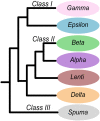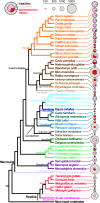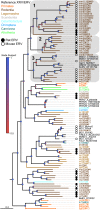Broad-scale phylogenomics provides insights into retrovirus-host evolution
- PMID: 24277832
- PMCID: PMC3864273
- DOI: 10.1073/pnas.1315419110
Broad-scale phylogenomics provides insights into retrovirus-host evolution
Abstract
Genomic data provide an excellent resource to improve understanding of retrovirus evolution and the complex relationships among viruses and their hosts. In conjunction with broad-scale in silico screening of vertebrate genomes, this resource offers an opportunity to complement data on the evolution and frequency of past retroviral spread and so evaluate future risks and limitations for horizontal transmission between different host species. Here, we develop a methodology for extracting phylogenetic signal from large endogenous retrovirus (ERV) datasets by collapsing information to facilitate broad-scale phylogenomics across a wide sample of hosts. Starting with nearly 90,000 ERVs from 60 vertebrate host genomes, we construct phylogenetic hypotheses and draw inferences regarding the designation, host distribution, origin, and transmission of the Gammaretrovirus genus and associated class I ERVs. Our results uncover remarkable depths in retroviral sequence diversity, supported within a phylogenetic context. This finding suggests that current infectious exogenous retrovirus diversity may be underestimated, adding credence to the possibility that many additional exogenous retroviruses may remain to be discovered in vertebrate taxa. We demonstrate a history of frequent horizontal interorder transmissions from a rodent reservoir and suggest that rats may have acted as important overlooked facilitators of gammaretrovirus spread across diverse mammalian hosts. Together, these results demonstrate the promise of the methodology used here to analyze large ERV datasets and improve understanding of retroviral evolution and diversity for utilization in wider applications.
Conflict of interest statement
The authors declare no conflict of interest.
Figures




References
-
- Jern P, Coffin JM. Effects of retroviruses on host genome function. Annu Rev Genet. 2008;42:709–732. - PubMed
-
- Stoye JP. Studies of endogenous retroviruses reveal a continuing evolutionary saga. Nat Rev Microbiol. 2012;10(6):395–406. - PubMed
-
- Stoye JP, et al. Retroviridae. In: King AMQ, Adams MJ, Carstens EB, Lefkowitz EJ, editors. Virus Taxonomy: Classification and Nomenclature of Viruses: Ninth Report of the International Committee on Taxonomy of Viruses. San Diego: Elsevier Academic; 2012. pp. 477–495.
-
- Feschotte C, Gilbert C. Endogenous viruses: Insights into viral evolution and impact on host biology. Nat Rev Genet. 2012;13(4):283–296. - PubMed
Publication types
MeSH terms
LinkOut - more resources
Full Text Sources
Other Literature Sources
Miscellaneous

